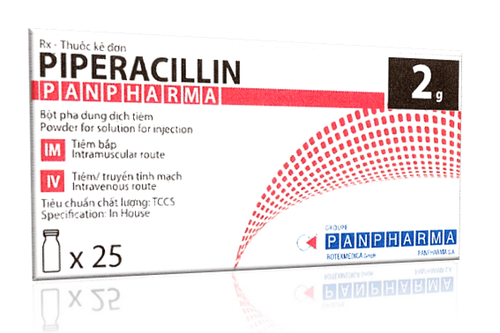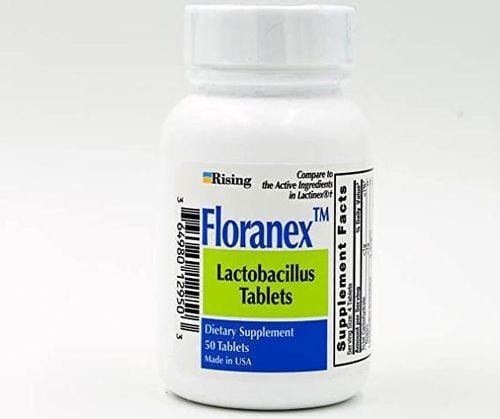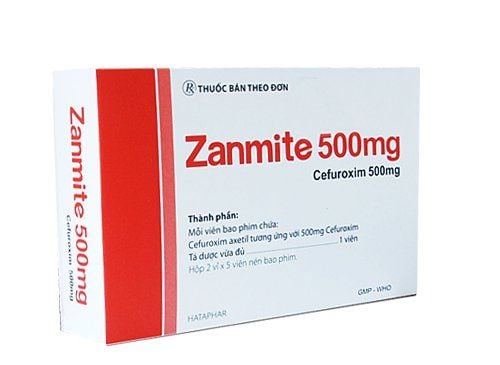This is an automatically translated article.
Sitacef is a drug used for the purpose of preventing and destroying bacteria by inhibiting the enzyme that synthesizes bacterial cell walls. The drug is suitable for patients with sepsis, meningitis or blood poisoning....1. What are the effects of Sitacef?
Sitacef is prepared as a powder for injection, containing the main ingredient is Ceftazidime. This is an active ingredient that prevents and destroys bacteria by inhibiting enzymes that synthesize bacterial cell walls. In addition to the Bacteroides enzyme, the active ingredient Ceftazidime in Sitacef is stable to most beta-lactamases of bacteria but is sensitive to gram-positive bacteria that are resistant to ampicillin and a few other cephalosporins. In addition, Ceftazidime is also sensitive to many gram-negative bacteria that are resistant to aminoglycosides.
2. Indications and contraindications
2.1. Indications Sitacef is indicated for use in the following cases:
Patients with sepsis, lung abscess or meningitis. People with urinary tract and lower respiratory tract infections. People with pneumonia, skin, soft tissue, bones and joints. People with diseases of the gastrointestinal tract, liver and gallbladder. Support the treatment of infections in immunocompromised patients. 2.2. Contraindications Sitacef is contraindicated in the following cases:
People who are hypersensitive to the active ingredient Ceftazidime pentahydrate contained in Sitacef or any of its ingredients. People with a history of shock when using Sitacef. Hypersensitivity to cephalosporin antibiotics.
3. Usage and dosage
The drug Sitacef is used by intravenous injection, deep intramuscular injection or intravenous infusion. However, users should note that Sitacef should not be combined with Sodium Bicarbonate solution because it will make the drug less stable than when combined with some other injection solutions.
Dosage of Sitacef will depend on the age of the disease, susceptibility and severity of the disease. In addition, the doctor also needs to pay attention to the patient's weight and kidney function.
3.1. Dosage of Sitacef for adults For patients using conventional medicine: Use with a dose of 0.5 - 2 grams, divided into 2-3 times a day through intramuscular or intravenous injection. . For patients with urinary tract infections or some mild infections: Use at a dose of 500mg or 1 gram every 12 hours via intramuscular or intravenous injection. Dosage for most infections: Use at a dose of 1 gram every 8 hours or a dose of 2 grams every 12 hours, intramuscularly or intravenously. Dosage of Sitacef for the treatment of serious infections (Including neutropenic patients): Use at a dose of 2 grams every 8 hours or 3 grams (potent drug) every 12 hours by injection. intramuscularly or intravenously. Dosage for the treatment of pancreatic cystic fibrosis: Patients with cystic fibrosis with normal renal function but with Pseudomonas lung infection need high doses of Sitacef from 100 to 150 mg/kg body weight/day, divided into 3 times. use/day by intramuscular or intravenous injection. 3.2. Dosage for children Dosage for children over 2 months old: Use about 30-100mg/kg body weight/day, divided into 2-3 doses. Dosage for children over 2 months of age with pancreatic cystic fibrosis due to infection, meningitis, children with impaired immune function: Use at a dose of 150mg/day. Dosage for infants and children under 2 months of age: Use with a dose of 25-60 mg/kg body weight/day, divided into 2 oral doses/day. 3.3. Dosage of Sitacef for the elderly The dose of Sitacef should not exceed 3 grams, especially in patients over 80 years old.
3.4. Dosage for people with impaired renal function Because Sitacef is excreted more slowly than in normal people, the dose should be reduced for people with impaired renal function.
4. Side effects
In the process of using Sitacef, patients may experience some of the following side effects:
Common side effects when using Sitacef:
Often appear local reactions such as allergies and irritation, pain, thrombophlebitis. Rare side effects when using Sitacef:
For the liver: Increases phosphatase, increases alkaline transaminases and causes jaundice. For stomach and intestines: Occurrence of pseudomembranous colitis with bloody stools and severe colitis. Shock: Leads to disturbances of touch, taste, hearing, dizziness and sweating. Superinfection: Sitacef has a risk of superinfection with Enterococci and Candida. For blood: Increases platelet count, agranulocytosis and hemolytic anemia. In the process of using Sitacef for treatment, if the patient notices any unusual symptoms suspected of using Sitacef, they should stop taking the drug immediately, consult a pharmacist or doctor. for timely and effective treatment.
5. Drug interactions
Patients should be careful when using Sitacef with the following medicines:
Antibiotics belonging to the Aminoglycoside group. Some high-potency diuretics such as furosemide.
6. Be careful when using Sitacef
Before using Sitacef, the patient should pay special attention to the following:
It is necessary to inform the doctor if you are sensitive to β-lactam antibiotics, penicillin or have a history of allergic urticaria, bronchial asthma and rash... Subjects who cannot eat normally, are receiving nutrition by intravenous route, people with poor health, elderly patients need to be closely monitored when using Sitacef. . Long-term use of Sitacef may lead to overgrowth of some bacteria that are not sensitive to the drug. Therefore, patients need to strictly adhere to the dose recommended by the doctor. Intravenous administration of Sitacef can cause thrombophlebitis and vasculitis. Therefore, extreme care should be taken when preparing the injection solution, the method of injection, and the injection site. After reconstitution, the solution for injection should be used immediately and administered intravenously at a slow rate. In case of drug overdose, the patient should be carefully monitored and appropriate supportive measures such as hemodialysis or peritoneal dialysis with the aim of rapid drug elimination. Above is the basic information about ingredients, dosage, usage and notes when treating diseases with Sitacef. However, this information is for reference only, patients should take the medicine under the guidance of the doctor.
Please dial HOTLINE for more information or register for an appointment HERE. Download MyVinmec app to make appointments faster and to manage your bookings easily.













